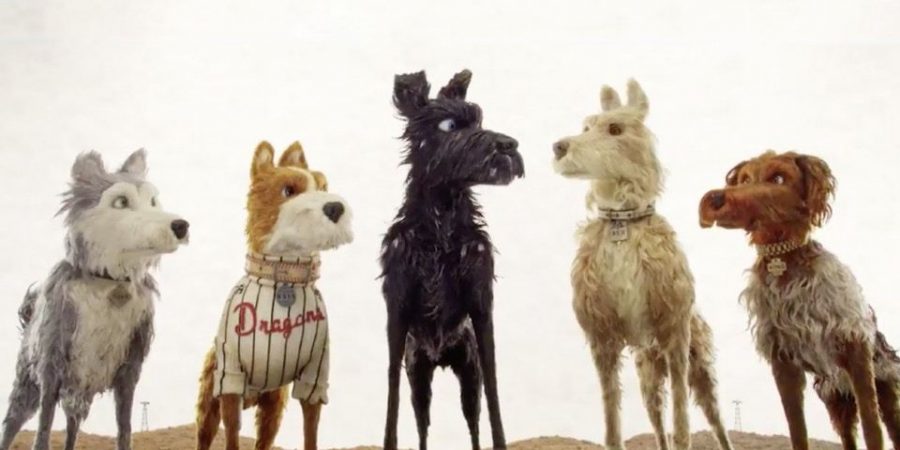Fresh off the Turntable: Isle of Dogs
In the spirit of the Oscars, we are going to look at the soundtrack for my favourite movie of all time, Wes Anderson’s Isle of Dogs. With a surprisingly amazing original score, featuring a combination of traditional Japanese instruments and techniques, Isle of Dogs’ story is helped along by the strong beats of a taiko drum. This soundtrack, arranged and partially performed by Alexandre Desplat, was his third time working with director Wes Anderson, having also arranged and composed music for both The Fantastic Mr. Fox and Grand Budapest Hotel. Desplat has won two oscars for Best Original Score, for Grand Budapest Hotel in 2014 and for 2017’s Shape of Water, which also has a fantastic soundtrack. Overall, he has proven to be a brilliant and culturally diverse composer, who does a fantastic job of fitting the theming of his arrangement to the style and theme of any genre of film.
Isle of Dogs is set in a post-modern and slightly dystopian Japan, where all dogs have been infected by a canine influenza. They are decreed by the mayor of the fictional Megasaki City, to be deported to a place referred to as “Trash Island,” a waste dump for the entirety of Japan. The dogs subsist off of scraps on the island for six months, until the mayor’s orphaned nephew, Atari Kobayashi, travels in a makeshift plane to the island to find his loyal service dog, Spots. Here, he crash lands, and works with a pack of dogs to find his friend, fighting his uncle’s policies and dog-banning decrees on the voyage.
Taiko drumming, used throughout the film, is a traditional Japanese style which involves the use of very large drums, loud, accented strikes, and tightly choreographed movements. The film opens with a stop-motion recreation of a typical Taiko show, which is accompanied by chanting and a series of bells. This style helps to emphasize Wes Anderson’s sarcastic, witty tone, and the motif will be used and replayed throughout the movie in several other songs and scenes.
The movie moves on to a series of fairly simple and melodic tones with “The Municipal Dome,” which slowly builds to a climax during the deportation of the first dog to Trash Island. “Six Months Later + Dog Fight” then helps to convey the aggressive, yet helpless nature of the dogs in a montage of their life on the overpopulated island. “The Hero Pack” and “First Crash-Landing” are both played during and after Atari’s crash, and the use of a bassoon helps to convey both the confusion and interest of the dogs in the boy.
My personal favourite song in the score, David Mansfield’s “Kosame No Oka,” is used during a discussion between two dogs, Chief and Nutmeg, discussing the hope Atari’s arrival brings to the island and their former lives and dreams. The overwhelming sadness of this scene, and the understanding between the two dogs of their inevitable deaths without their loved ones and masters on Trash Island, is emphasized by the sole guitar’s soft and melancholic chords. “Kosame No Oka,” originally from a 1947 film Drunken Angel, is used fantastically in this scene, and though it takes a background role to the discussion, it perfectly conveys the feeling and despair of the first two parts of the film.
The next song, “I Won’t Hurt You” by The West Coast Pop Art Experimental Band, is used as a soft backing track for the pack’s search for Spots, during a kind of montage scene. The soft, heartbeat like rhythm of the song is used in tempo with their steps, as the gentle guitar melodies move the story on to its second chapter. My favourite section in the movie, backed by a track titled “Sushi Scene,” shows the elaborate murder of the scientist, who was the head of dog-flu cure research, with a wasabi-poison inside of his sushi roll. The scene depicts the creation and delivery of his food in perfect tempo, with impressive animation and cinematography to boot.
The next few tracks, “Pagoda Slide,” “First Bath of a Stray Dog,” and “Toshiro” all assist the deepening of Chief and Atari’s friendship. “Pagoda Slide” begins with two dueling bassoons who eventually come together to melodize, which perfectly represents the breaking down of Chief’s emotional barriers. Overall, these three tracks help move the story forward and help the viewer see the development of these characters.
“Re-Election Night, Parts 1-3” is the penultimate track on Isle of Dogs’ score, and helps to convey the anger and emotion between Atari, the Dogs, and Mayor Kobayashi. The slow build to the climax through increasing musical complexity and the addition of chanting and more drums to the original single drumbeat prepares the viewer for the ensuing fight. The five minute track ends with a slow fading of all instrumentals, resulting in a perfect musical dramatic arc, with a beginning, climax, and finale.
“Midnight Sleighride” plays during the epilogue, and the use of drums and a small orchestra help to quickly move the pace along during the cuts between each character and their return to Megasaki City. This epilogue concludes with a repeat of the film’s first song, “Taiko Drumming,” which emphasizes the effect that Japan and the Japanese style had on the score and culture of the film.
Overall, Isle of Dogs is a fantastic movie with an amazing score, and deserves both the Oscar for Best Original Score and Best Animated Feature (though Spiderman: Into the Spider Verse was absolutely fantastic as well.)






